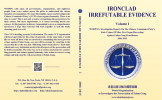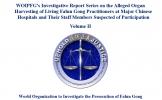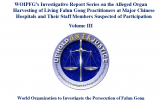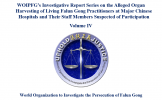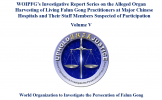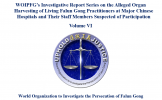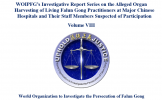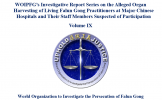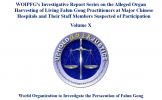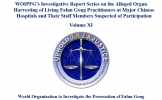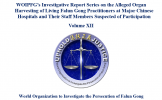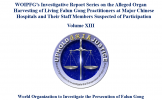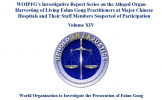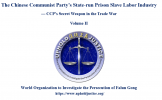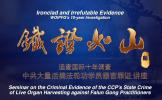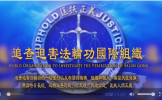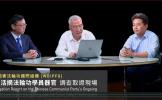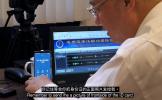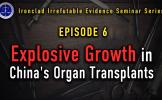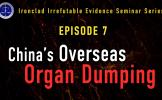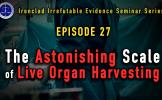Washington Post Endorsed Lies from the Chinese Communist Party Regarding China’s Organ Transplantation Industry. WOIPFG Presents Evidence of Forced Live Organ Harvesting in Refutation
On September 15, 2017, the Washington Post published an article titled, “China Used to Harvest Organs from Prisoners. Under Pressure, that Practice is Finally Ending”[1]. The article claims that, thanks to “the perseverance” of Huang Jiefu, the former Vice Minister of Health, the Chinese Communist Party [CCP] had stopped using organs from death-row inmates. Even though this report tries to endorse Huang Jiefu’s lies, its contents are not self-consistent, nor can it deny the presence of forced organ harvesting from live Falun Gong practitioners in China. The CCP has been denying harvesting organs from live Falun Gong practitioners. However, various research findings have shown that Falun Gong practitioners have become the main donor sources for organ transplantation in China, ever since the CCP started the large-scale persecution against Falun Gong. The Washington Post’s article is doing nothing other than whitewashing the lies fabricated by the CCP and Huang Jiefu and helping conceal their crime of live organ harvesting. In this report, World Organization to Investigate the Persecutions of Falun Gong [WOIPFG] will let the facts speak for themselves and analyze the arguments stated in this Washington Post article one by one.
I. Can Executed Prisoners Really Ensure the Supply of An Enormous Number of Organs for Transplantation?
The Washington Post article claims, “The use of prisoners’ organs had left China a global pariah in the transplant field. Relying on prisoners caught in a corrupt and inhumane legal system, China had built the world’s second-largest transplant industry after the United States’.” According to WOIPFG’s research, the use of executed prisoners’ organs couldn’t have explained the large number of organ transplants and the abnormally abundant supply of organs in China.
A. Number of “Death-row Inmates” is Far Less than the Number of Organ Transplants
On March 7, 2013, Huang Jiefu, former Vice Minister of Health was interviewed by the “Southern Metropolis Daily”. He said in the interview, “Over a decade ago, the death sentences started to decrease by a rate of 10% per year. Currently, in fact, there are very few death-row inmates.”[2] On the other hand, Huang Jiefu had been claiming that the number of organ transplantation surgeries in mainland China had been consistently increasing over the past decade. If executed prisoners had been the main source of organs, then the number of death sentences should also have been increasing, in order to keep up with the increase in organ transplantation surgeries.
According to Amnesty International, during the 5 years before and after the CCP’s persecution of Falun Gong started, the number of death sentences averaged over 1,600 per year.[3] However, the number of kidney transplants officially published by the CCP far exceeded the number of executed prisoners. Even the number of organ transplants [5,500 to 10,000 cases per year] provided by Huang Jiefu would far exceed the number of executed prisoners. [4]
B. Due to Health Problems, Very Few Death-row Inmates can be Used as Organ Donors
- In 2009, Hangzhou City in Zhejiang Province conducted a test of hepatitis B among 482 prison inmates. The infection rate was found to be as high as 29%.[5]
- A medical examination was conducted among some inmates in Heze City, Shandong Province in 2006. The results showed that the AIDS and syphilis infection rate was 1.29%, while hepatitis B and C infection rate was 28.91%.[6]
C. Extremely Short Organ Wait Times
- According to a United States Department of Health report in 2007, the average wait time for organ transplantation in the United States is 2 years for liver transplantation and 3 years for kidney transplantation.[7]
- In China, the average organ wait time is 2 to 4 weeks and can even be as short as 1 to 2 weeks. Typically, the organs are ready waiting for patients to show up. This is the unique reverse organ matching in the entire world.[8]
D. Extremely Abundant Organ Supplies
- 26.6% of liver transplants are emergency cases: The so-called emergency liver transplants are those performed on acute liver illness patients with less than 72 hours to survive. Due to the difficulty in emergency organ matching and the long wait times, emergency liver transplants are rarely carried out in foreign countries. In China, however, emergency liver transplants have become very common after year 1999. According to data from the 2006 Annual Report on China Liver Transplant Registry,[9] 8,486 cases of liver transplants were performed in 29 transplant centers from April 6, 2005 to December 31, 2006. Among these cases, 4,331 had been specified whether or not they were emergency transplant operations. There were a total of 1,150 emergency liver transplants performed, or 26.6% of all the specified liver transplants. In the case of the fastest transplant operation recorded in the data set, one patient received a liver transplant operation only four hours after being hospitalized.[10]
- A new donor organ would be selected after abnormality was discovered during an operation, and another organ transplant surgery would be performed within one week. The China International Transplant Network Assistance Center (CITNAC) of the Affiliated Hospital of China Medical University in Shenyang has claimed that if abnormalities are found in the donor organs provided by the Center, they would select new donors for such patients and perform transplant operations for them again within one week after the cancellation of the first operations.[11]
- The Hunan People’s Hospital advertised 20 cases of free liver transplantation, as a means of sales promotion.[12]
- In a promotion campaign of the Jilin Heart Hospital, the first five cases of heart transplantation would only cost the patients 50,000 yuan each.[13]
- From June 1 to June 30, 2017, Jilin Provincial Travel Radio and the Hepatic Transplantation Center of the First Hospital of Jilin University jointly launched a program of free liver transplantation for 10 children.[14] These liver transplant operations would cost over 100,000 yuan (around $20,000) each, and all the transplant surgery fees were waived.[15]
Executions of death-row inmates must be approved by the Supreme Court, and the executions must be carried out by the Public Security Bureau at predetermined times. According to Criminal Code of Prosecutions, Article 210, the Supreme Court’s Chief Justice must sign an order of execution, for any immediate death sentences issued and verified by the Supreme Court. The execution order from the Supreme Court and the High People’s Court must be sent to the court of original jurisdiction. Upon receiving the order, the court of original jurisdiction must carry out the execution within seven days.[16] Therefore, executions of death-row inmates cannot be carried out at arbitrary times. Based on the above reasoning, there is a large live organ donor pool that exists outside of the judiciary system.
II. Have the Large Financial Interests of China’s Organ Transplantation Experienced Any Changes around Year 2015?
The Washington Post article claims, “‘Financial interests were driving malpractice,’ Huang said. ‘The allocation of organs had become a game of wealth and power, with no social justice.’ Thousands of organs were being harvested from executed prisoners every year, but over the course of a decade, Huang has garnered support at the highest levels of government and succeeded in pushing China’s medical establishment into dropping the often-lucrative practice.”
Huang Jiefu said that before year 2015, organ transplantation had generated large financial interests. Then how about after 2015? Actually, the situation didn’t change at all. Organ transplantation has still been generating a lot of profit. For example, Zhejiang University International Hospital, officially established on April 29, 2015, is a non-public medical institution affiliated with Zhejiang University, and its investor is Shulan Medical Group, which was established in 2013. “Shulan” is composed of two Chinese characters, which are taken from the names of Zheng Shusen and his wife Li Lanjuan. The group’s president is their son, Zheng Jie. In the newly established Zhejiang University International Hospital, Zheng Jie serves as the vice president in charge of finances and HR. Zhejiang University International Hospital is actually a private enterprise of Zheng Shusen’s family, under the name of “a hospital affiliated with Zhejiang University” to attract organ transplant business. The key to organ transplant surgeries is the donor availability. Zheng Shusen has access to organ sources, so he is reluctant to share profits with Zhejiang University and the university’s hospital. This is one of the reasons for him to set up his own private hospital.
The Washington Post article praises Huang Jiefu’s decade-long perseverance to stop the use of executed prisoners’ organs. Then from where did the organs he used for his operations come? According to Huang Jiefu’s revelation to Guangzhou Daily in March 2013, he performed over 500 liver transplants in 2012 alone, and only one of them was from voluntary donation.[17]
It is claimed by the article that “over the course of a decade, Huang has garnered support at the highest levels of government”. So from which high-ranking officials did he garner support? Huang openly pointed out to Phoenix Satellite Television on March 15, 2015 that “Zhou Yongkang is the ‘big tiger’. Zhou Yongkang is our [Central] Political and Legal Affairs Commission’s secretary... So where is the source of the executed prisoners’ organs from? Isn’t it very clear?”[18] A New York Post article quoted senior China expert Ethan Gutmann’s investigations in August 2014 to point out that the former CCP Standing Committee member Zhou Yongkang was one of the major individuals involved in the system to extract Falun Gong practitioners’ organs.[19] According to “Beijing Spring” magazine’s honorary editor-in-chief Hu Ping, this statement by Huang Jiefu indirectly confirmed the allegations of the removal of organs from Falun Gong practitioners.[20]
III. Have the Large Financial Interests of China’s Organ Transplantation Experienced Any Changes around Year 2015?
The Washington Post article claims, “Since 2010, Huang has slowly built the register of voluntary donors, who now meet the needs of patients who require transplants.” “Last year, Huang said, 4,080 donors supplied organs after their deaths, and 2,201 living donors gave organs to relatives. In total, China performed 13,238 organ transplant operations, mostly of kidneys and livers, but a few hundred hearts and lungs, too. None of those came from prisoners, Huang said.”
Huang Jiefu has claimed that the use of executed prisoners’ organs was stopped in January 2015, and since then, donated organs from Chinese citizens had been used instead. Then, how does organ donation work in China?
A. An Inefficient Organ Donation System
- When being interviewed by the “New York Times” and the “Beijing Youth Daily” on November 18, 2015, Huang Jiefu revealed that China’s so-called organ donation system was actually in a paralyzed state, and it was not functioning at all. “When being asked about the largest current problem, he admitted frankly that the coordination between the two most important departments in the organ donation system, the Red Cross Society and the National Health and Family Planning Commission, was not smooth. Both departments jointly established the National Organ Donation and Transplant Commission on March 1, 2014, but it was like non-existent, as ‘so far no meeting has been held yet’. As the commission’s chairman, he was very helpless and worried about it.”[21]
- Most investigating phone calls from the WOIPFG investigators to the Chinese Red Cross Society organ donation offices went unanswered. Several people, who answered the calls, stated that very few donations were successfully made.
- From December 6 to 17, 2015, WOIPFG investigated the Red Cross Society organ donation offices in Beijing, Tianjin, Shanghai and several other cities. The Red Cross Society organ donation system in Beijing was still under construction, Tianjin only had “over 170 donated organs since the establishment of the organ bank in 2003”, and Shanghai had “only 5 cases of successful organ donation up to now.”[22] On May 14, 2015, a staff member at the organ donation office of the Qinhuangdao Red Cross Society said, “There are people who have registered for organ donation…but none of them has donated their organs yet.”[23]
B. The Number of Registered Organ Donations doesn’t Match the Number of Successful Donations
- Currently, the CCP government claims that there are 300,000 people having registered for organ donation in China. The United States has 140 million registered organ donors, and the UK has about 21 million people registered for organ donation. However, even with so many registered donors, the United States only had 15,951 people donating their organs in 2016; and the UK had only 1,364 people.[24]
- Taking into account the mortality rate of 7/1000 and other factors, such as organ donors’ illnesses, unhealthy lifestyles, ages, and the time lapses between death and organ extraction, ultimately only 1% -2% of the registered organ donors would meet the requirement for organ transplantation after their deaths. If the above reasoning is applied to the 300,000 alleged Chinese organ donors, the result would be: In 2016, 7/1000 of these 300,000 individuals would pass away, so that would be approximately 2,100 people. Among the 2,100 people, who have registered for organ donation and who were passing away in 2016, only 1% to 2% of them could provide organs for successful transplantation. That is, there would be only 21 to 42 organ donors in 2016. However, the CCP claimed that there were more than 4,000 organ donors in 2016. This means that the CCP’s organ donors came from other sources.[25]
C. Chinese Organ Transplant And Donation System is Non-Transparent, Non-Traceable and Inaccessible
The Washington Post article writes, “‘Our system is transparent and traceable,’ he [Huang Jiefu] said. ‘We know where every organ comes from and where every organ goes’.”
In 2006, after the CCP’s crime of live organ harvesting was exposed, a number of independent investigators in the international community tried to travel to China to investigate. However, their visa applications were all denied, including the Canadian human rights lawyer David Matas and former Canadian Secretary of State, Asia-Pacific, David Kilgour. In order to assess whether a country’s organ transplant and donation system is in line with the World Health Organization’s standards, it is important to ensure that at any given time, independent investigators are able to inquire about the organ sources, the donors’ relatives, the causes of the organ donors’ death and whether the voluntary organ donation agreements were signed under free and informed circumstances. This is the norm for all Western countries. In China, we just see the opposite. The CCP prevents people from accessing its organ transplant system’s database. Hong Kong has an organ registry, which was open to the public. A few years ago, the CCP started to prevent the public from accessing this database, and currently people are unable to access it. So, no one can see how many organ transplant surgeries they have performed.
IV. A Large Number of Organ Transplants with Extremely Short Wait Times have taken place across China
The Washington Post article states, “… agreed that an abrupt end to the use of prisoners’ organs was not feasible and would only create a black market. Instead, they resolved to work for gradual change.” “Yet the supply of organs from executed prisoners seems to have been drying up because the number of death sentences appears to have fallen dramatically after a 2007 mandate requiring the Supreme Court to review all capital cases.”
According to this article, Huang Jiefu believed that an abrupt end to the use of prisoners’ organs would lead to a lack of donor organs and the formation of a black market. However, WOIPFG’s investigations have confirmed that after the use of executed prisoners’ organs was allegedly terminated in January 2015, a large number of organ transplants have still been carried out with an abundant supply of donors and extremely short wait times. Some hospitals even had “green channels” for emergency liver transplants. And some hospitals had more organs than needed, so they tried to find more patients to perform transplants. WOIPFG has also discovered that this is a common phenomenon all across China, including in Beijing and Shanghai, where the numbers of organ donations were extremely small.[26]
A. “Green channels” are provided to patients with severe liver failures to have emergency liver transplant operations. In March 2016, a liver transplant surgeon named Lang Ren at Beijing’s Chaoyang Hospital said, “If [the patient’s situation is] very grave, we have a green channel.” “A maximum, a maximum of two weeks to wait [for the organ], in our hospital, because we have an ample supply of donors.” “We have already performed a more than a dozen [organ transplant surgeries] this year.”[27] [Please see Appendix 1 for the transcription of the investigative phone call recording.]
B. Chen Jingyu, vice president of Wuxi People’s Hospital, was hailed as “the No.1 lung transplant surgeon in China”, said publicly on August 13, 2015, “I originally thought that the lung donors might be less this year due to the abolishment of the use of death-row inmates as donors. However, we now have one lung transplant every three days, and we just get busier than last year.”[28]
C. Wait times are still extremely short: All hospitals that WOIPFG investigated recently are still performing large numbers of organ transplants, and they are actively seeking more patients by means of marketing and advertising. In their advertisements, they would claim that they have an ample supply of organ donors, who are guaranteed to be healthy and the wait times would be short. The wait times for liver transplants range from 2-3 days to 1-2 weeks. In general, a matching donor would be found in less than a month.[29]
V. Why we don’t see an increase in the demand for overseas immunosuppressant drugs, when there is a surge in organ transplants in China?
The Washington Post article also states, “Transplant patients must take immunosuppressant drugs for life to prevent their bodies from rejecting their transplanted organs. Data compiled by Quintiles IMS, an American health-care-information company, and supplied to The Post, shows China’s share of global demand for immunosuppressants is roughly in line with the proportion of the world’s transplants China says it carries out.”
With regard to organ preservation solutions used during transplant operations and immunosuppressant drugs that patients reply upon after their transplant operations, many people are wondering, “Why is that we don’t see a significant increase in the purchase of these drugs from the international market, when China’s organ transplant industry has been experiencing a dramatic surge?” WOIPFG has discovered that many organ transplant organizations in China have been engaging in the research and development of such drugs since a long time ago, in order to maximize their profits from conducting organ transplants. Most hospitals performing organ transplants are using the products developed and produced in China to replace imported immunosuppressant drugs.
- For example, Li Leishi, a member of Chinese Academy of Engineering and director of the Kidney Disease Research Institute at Nanjing General Military Hospital, discovered the unique and outstanding immunosuppressing effect of triptolide (monomer), extracted from the Chinese herb Tripterygium wilfordii.[30] Li Yantang, director of the Urology Department of the PLA’s General Hospital, and his student Qian Yeyong also conducted research on the use of traditional Chinese medicine Tripterygium wilfordii polyglycoside as a kidney transplant immunosuppressant, with the funding provided by the National Natural Science Research Foundation of China.[31] Qian Yeyong was the first person, who applied the polygycoside extracted from Tripterygium wilfordii in actual human organ transplants with success. [32]
- In mainland China, there are 396 patents related to organ transplants. Among several hundreds of Chinese patents in the field of organ transplantation, WOIPFG has found that about 50% are related to organ preservation solutions and/or immunosuppressant drugs. From year 1999 to present, 396 patents in the field of organ transplantation have been invented. Among them, 253 are related to immunosuppressant drugs, accounting for 68.9%.[33]
- Shanghai’s Changzheng Hospital of the Second Military Medical University was one of the first in China to perform kidney transplants. With the support of the Science and Technology Commission of Shanghai Municipality [STCSM], Zhu Youhua, a member of the Military Organ Transplantation Institute, and his team were the first to finish the research on the kidney and multi-organ preservation solutions, and put it into clinical application more than 20 years ago, so that China’s research in this field is at the forefront in the world.[34] As displayed on Changzheng Hospital’s archived webpage, “98% of the Chinese hospitals use the organ preservation solution that we’ve developed.”[35]
VI. Contradictory Reports on the Scale of Organ Transplantation in China
The Washington Post article claims, “Chapman and Millis say it is ‘not plausible’ that China could be doing many times more transplants than, for instance, the United States, where about 24,000 transplants take place every year, without that information leaking out as it did when China used condemned prisoners’ organs.”
The number of organ transplants in China has long been a top secret. However, just by adding the transplant numbers in a few organ transplant centers, the sum would far exceed the officially claimed figure, which is 10,000. As of December 2014, WOIPFG had confirmed that 9,500 surgeons in 865 hospitals had been involved in organ transplants, and among them, 712 hospitals were dedicated to liver and kidney transplants.[36] These hospitals are all over China, in 22 provinces, 5 autonomous regions, 4 central government directly-controlled municipalities and 217 prefecture-level cities. They also include military and armed police hospitals, as well as a significant number of Chinese medicine hospitals, forensic hospitals, children’s hospitals, county-level hospitals and specialist hospitals, which are not qualified to perform organ transplants.
A. Contradictory Data: In a medical paper published in 2016, Zheng Shusen, vice president of the Chinese Medical Doctor Association, claimed that 564 liver transplants were performed at Zhejiang University’s First Affiliated Hospital from April 2010 to October 2014 and that all organs were from cardiac-dead donors.[37] In contrast, Huang Jiefu once claimed that, from 2011 to 2014, Zhejiang University’s First Affiliated Hospital obtained 166 livers for transplantation, several times smaller than the figure stated by the hospital itself.[38]
B. China’s liver transplant volume ranks first in the world: Wu Mengchao, the so-called “Father of Chinese Hepatobiliary Surgery” and Chief Advisor of the Army Organ Transplantation Academic Conference, is the president of the Eastern Hepatobiliary Surgery Hospital, which is affiliated with the Second Military Medical University. Wu once boasted that the CCP’s liver transplant volume was the largest in the world. On May 11, 2011, Meng said in an interview with Sina.com, “In terms of liver transplants, our quantity has been the largest in the world. And the quality and results are also good. We have caught up with the international standards.”[39] Considering that the U.S. performs 6,000 liver transplants per year,[40] and between 2004 and 2015, the volume of kidney transplants was three times of that of liver transplants,[41] that means, the U.S. performed around 18,000 kidney transplants a year. Then according to Meng’s statement, China would have performed at least 24,000 liver and kidney transplants. [24,000 = 6,000 + 18,000] Heart, lung, small intestine or pancreas transplants are not even counted here, yet the number of liver transplants is already 2.4 times of the official claimed number, which is 10,000.
C. Media revealed the actual numbers of organ transplants:
a. “China Economic Weekly”: Peking University People’s Hospital once carried out 4,000 cases of liver and kidney transplantation within one year.[42]
b. “China Times”: The No. 175 Hospital in Nanjing Military Region “carried out at least 3,000 cases of kidney transplant every year”[43]
c. “Kwong Wah Yit Poh”: Wuhan Tongji Hospital performs thousands of kidney transplants per year.[44]
D. Estimated organ transplants based on the number of hospital beds and bed utilization rates: Let’s take Oriental Organ Transplant Center, which was mentioned in the Washington Post article, as an example. The Tianjin municipal party committee and the municipal government invested about 170 million yuan to build the Oriental Organ Transplant Center at the Tianjin First Central Hospital. The organ transplant building of 46,000 square meters was completed and put into use in August 2006.[45] The new organ transplant center has more than 500 hospital beds on 16 floors, and it has become the largest organ transplant center in Asia. This organ transplant center is capable of simultaneously performing 9 liver transplants and 8 kidney transplants. Based on these numbers: 500 beds for organ transplantation,[46] the bed utilization rate of 131.1%,[47] the average hospitalization duration of 25-30 days for liver transplants: [the average hospital stay for kidney transplants would be 30 days], the estimated annual transplant volume would be: 7,975 cases [= 500 beds × 365 days × 131.1% / 30 days]. [Here, the hospitalization duration used is 30 days, which would be considered relatively conservative.]
VII. Data on China’s Political Prisoners
The Washington Post article states, “A U.S. congressional commission on China, the State Department and the Falun Gong community website have separately tried to estimate the number of political prisoners in China, and the figures range from 1,397 to “tens of thousands” — and even that upper number is significantly lower than the 500,000 to 1 million claimed by Gutmann and others.”
It’s unclear to WOIPFG from where the Washington Post obtained the above figures. However, it appears that the author of this article was playing a word game with the concepts of “political prisoners” and “prisoners in custody”. Many human rights institutions do not classify the detained Falun Gong practitioners as “political prisoners”. And the Washington Post should also be aware of the fact that most detained Falun Gong practitioners have not been held in prisons, but in labor camps [before they were abolished], re-education centers, mental hospitals, transformation centers and illegal jails. Also, the websites established by Falun Gong practitioners don’t state that only tens of thousands of Falun Gong practitioners are in detention. International observers have estimated that hundreds of thousands or even millions of Falun Gong practitioners have been detained in labor camps, prisons and other detention facilities.[48] According to the investigations conducted by “Freedom House”, the “610 Office”, which was specifically established to suppress Falun Gong practitioners, spends 879 million yuan [approximately $135 million] annually.[49]
VIII. Is it really true that only a handful of foreign patients go to China for organ transplants as described in the Washington Post article?
The Washington post article states, “The symbolic focal point of China’s organ transplant industry is the Oriental Organ Transplant Center, a gleaming 14-story building in the northeastern city of Tianjin that is the largest of its kind in Asia.” “In the lobby, a sleek promotional video advertises the center’s expertise in supplying livers, lungs, hearts and pancreases to save thousands of lives every year. On a recent visit, a handful of patients from Pakistan, Libya and the Middle East were observed in transplant wards. Two Pakistani families said they had brought their own donors with them, although one admitted that the donor was not related to the recipient, in breach of Chinese law.”
Is it true that only a handful of patients go to China for organ transplants, as described in the Washington Post article?
- According to a report published in 2004 in the Sanlian Life Weekly magazine, in just a few years, tens of thousands of overseas organ transplant patients went to China, launching a type of “organ transplant tourism”. This article described the “grand spectacles” of organ transplant tourism, “In addition to the Koreans, the Tianjin First Central Hospital (aka the Oriental Organ Transplant Center) also has patients from nearly 20 Asian countries and regions, including Japan, Malaysia, Egypt, Pakistan, India, Saudi Arabia, Oman, Hong Kong, Macao and Taiwan.[50]
- On April 4, 2006, “Asia Times” published a report entitled “Japanese Flock to China for Organ Transplants”. The report noted that a hospital in a major city in China conducted 2,000 organ transplants in year 2005 alone. Among the transplant recipients, “some 30 or 40 were Japanese and 200 were Korean.”[51]
- On December 19, 2014, Huang Jiefu, the CCP’s former Vice Minister of Health, went to Taiwan in person to promote the “cross-strait organ transplant platform”, intending to “export” mainland Chinese organs to Taiwan.[52]
- Israel’s largest newspaper Yediot Aharonot reported that the Israeli government, after several months of investigation, arrested four men in August 2007, who served as middlemen to bring Israeli patients to Asia for organ transplants. The principal offender confessed to a reporter that “organs are from mainland Chinese death-row inmates and prisoners of conscience, including Falun Gong practitioners.”[53]
This Washington Post article resembles an investigative report, but with most of its quoted data coming from mainland China. It only interviewed one live organ harvesting suspect, Huang Jiefu, but it didn’t interview the investigators, who have been investigating the live organ harvesting in the past 12 years, including David Kilgour, David Matas and the WOIPFG [World Organization to Investigate the Persecution of Falun Gong] investigators. The government of the People’s Republic of China has always been denying the allegations of live organ harvesting since 2006 and refused to publish the relevant data at the request of the United Nations,[54] and it rejected the request for an independent investigation in mainland China by foreign organizations. However, this time, the regime allowed the Washington Post reporters to conduct investigations and interviews within China. This move per se is already shedding light on this issue. As the CCP is one of the top advertisers of the Washington Post, such financial interests have made the Washington Post cast its morals away once again.
[1] “The Washington Post”, September 15, 2017. “China used to harvest organs from prisoners. Under pressure, that practice is finally ending”.
[2] Peng, Xiaomei. “China Organ Transplant network website”, March 7, 2013, “90 percent of Doctors Don’t Understand Brain Death; Huang Jiefu Considers Legislation Immature”. Source: Southern Metropolis Daily.
Archived article link:
https://web.archive.org/web/20171230020627/http://www.transplantation.o…
[3] Organ Harvest Investigation Net. “Report into Allegations of Organ Harvesting of Falun Gong Practitioners in China”. Authors: David Matas and David Kilgour
http://organharvestinvestigation.net/report0607/report060706-eng.pdf
[4] WOIPFG. August 9, 2016. “Summary Report on the Crime of Live Organ Harvesting in China by the World Organization to Investigate the Persecution of Falun Gong.” http://www.upholdjustice.org/node/370
[5] “Journal of Radioimmunology”. 2010, Vol. 23, Issue No. 2. “Analysis on Hepatitis B Virus Infection among Detainees in Hangzhou”. Author: Yu Huijuan (Hangzhou Preventive Health Care Clinic Laboratory 310014)
WOIPFG archived article link: http://www.zhuichaguoji.org/cn/images/medicalarticles/113.pdf
[6] WOIPFG. August 3, 2016. “Summary Report on the Crime of Live Organ Harvesting inside China by the World Organization to Investigate the Persecution of Falun Gong – Chapters 6, 7, 8.” http://www.upholdjustice.org/node/362
[7] “OrganDonor.Gov”. The Matching Process – Waiting List. Source: the U. S. Department of Health
WOIPFG archived article link: http://www.zhuichaguoji.org/cn/images/nationalcriminalreports/57.png
[8] WOIPFG. August 9, 2016. “Summary Report on the Crime of Live Organ Harvesting in China by the World Organization to Investigate the Persecution of Falun Gong.” http://www.upholdjustice.org/node/370
[9] China Liver Transplant Registry 2006 Annual Report. WOIPFG archived article link: http://www.zhuichaguoji.org/cn/images/nationalcriminalreports/192.pdf
[10] WOIPFG. August 9, 2016. “Summary Report on the Crime of Live Organ Harvesting in China by the World Organization to Investigate the Persecution of Falun Gong.” http://www.upholdjustice.org/node/370
[11] WOIPFG. August 9, 2016. “Summary Report on the Crime of Live Organ Harvesting in China by the World Organization to Investigate the Persecution of Falun Gong.” http://www.upholdjustice.org/node/370
[12] WOIPFG. August 3, 2016. “Summary Report on the Crime of Live Organ Harvesting inside China by the World Organization to Investigate the Persecution of Falun Gong – Chapters 6, 7, 8.” http://www.upholdjustice.org/node/362
[13] Minghui.org. May. 9, 2006. “Extremely tragic atrocity is still ongoing.”
Retrieved from: http://www.minghui.org/mh/articles/2006/5/9/127277p.html
[14] Jilin Travel Radio Broadcast. June 2, 2017. “These Children’s Lives are in Jeopardy, there is a Life-saving Charitable Activity Worth a Million Yuan Here”. http://www.sohu.com/a/145446454_223169
[15] WOIPFG. June 27, 2017. “Another advertisement of free liver transplantation comes into sight in China!” http://www.upholdjustice.org/node/387
[16] Lawyers of Kunming, Yunnan Province website. June 21, 2017. “The Procedures for Death-row Inmates from Sentencing to Execution.” http://www.chinalawyeryn.com/xingshibianhu/sixingfuhe/20170621/54418.ht…
[17] Dayang.net. March 13, 2013. “Former Vice Minister of Health Huang Jiefu: I want to take the lead to bow to the organ donors”. Source: Guangzhou Daily News. Reporters: Liu Ruihong, Wang He, Li Ying and He Hanfu. “China Economic Weekly”. https://archive.is/cNGOl
[18] Sina.com. March 16, 2015. “Huang Jiefu: Zhou Yongkang’s downfall breaks the profit chain of organ transplant from executed prisoners.” Retrieved from http://news.sina.com.cn/c/2015-03-16/122231611694.shtml
[19] Larry Getlen. “China’s long history of harvesting organs from living political foes.” New York Post. August 9, 2014. https://nypost.com/2014/08/09/chinas-long-history-of-harvesting-organs-from-living-political-prisoners/
[20] Hu Ping. Indirect confirmation of organ harvesting from Falun Gong practitioners, “You Understand" Huang Jiefu's speech. Beijing Spring. March 26, 2015. Http://beijingspring.com/bj2/2010/140/2015326192219.htm
[21] “Sohu News”. Huang Jiefu: Whether death-row-inmates can donate organs is a pseudo-proposition. Source: Northern Youth Website. Author: Sun Jing. November 23, 2015. WOIPFG archived article link: http://www.zhuichaguoji.org/cn/images/nationalcriminalreports/300.png
[22] WOIPFG. “Special Report on the Crimes of Chinese Communist Officials in Live Organ Harvesting from Religious Practitioners and Dissidents.” February 5, 2017. http://www.upholdjustice.org/node/379
[23] WOIPFG. “The Chinese Communist Regime Continues Its Campaign of Forced Organ Harvesting from Living Falun Gong Practitioners.” November 27, 2015. http://www.upholdjustice.org/node/330
[24] Li Chen. “DAFOH: Chinese Communist Party’s Organ Donation Reform is just like the Disposal of Corpses by a Murderer.” August 14, 2017. http://www.epochtimes.com/gb/17/8/13/n9525585.htm
[25] Li Chen. “DAFOH: Chinese Communist Party’s Organ Donation Reform is just like the Disposal of Corpses by a Murderer.” August 14, 2017. http://www.epochtimes.com/gb/17/8/13/n9525585.htm
[26] WOIPFG. “WOIPFG’s Latest Investigation Results: in the Name of “Organ Donation”, CCP Continues to Harvest Organs from a Large Number of Living Falun Gong Practitioners.” July 15, 2016. http://www.upholdjustice.org/node/358
[27] WOIPFG. “WOIPFG’s Latest Investigation Results: in the Name of “Organ Donation”, CCP Continues to Harvest Organs from a Large Number of Living Falun Gong Practitioners.” July 15, 2016. http://www.upholdjustice.org/node/358
Appendix 1:
Lang Ren, liver transplant surgeon at Beijing’s Chaoyang Hospital (+86-13911757869), “If (the patient’s situation is) very grave, we have a green channel… because we have an ample supply of donors.” “We have performed more than ten transplants this year.”
The so-called green channel is to provide urgent transplant for severe liver failure patients.
Excerpt:
We have been doing liver transplants for more than ten years, over 1,000 cases. A maximum, a maximum of two weeks to wait (for the organ) in our hospital, because we have an ample supply of donors. We have already performed a more than a dozen (organ transplant surgeries) this year. Usually the cost is 700,000 RMB.
Phone Investigation Recording:
……
Investigator: Hello! Is this Doctor Lang Ren at Chaoyang Hospital? I, um, I am a doctor. I work at No. 316 Hospital. Can you do liver transplants?
Lang Ren: May I know who you are? (Investigator: Ah?) Who are you?
Investigator: Um, I am, we are at Haidian district, you know. At Haidian, Yuquan Mountain. No. 316 Hospital is under the PLA General Staff Department. I am a doctor and we have a patient here who would like to have liver transplant. Can you do that at your hospital?
Lang Ren: He certainly can have a liver transplant in any hospital in Beijing. We can do it at our hospital as well.
Investigator: Oh, because in some hospitals, they do a lot of transplants and they have a lot of patients waiting. I asked several hospitals and they told me they stopped doing it. The China-Japan Friendship Hospital stopped doing transplants. That’s why I asked if you do it or not.
Lang Ren: You are right, the China-Japan Friendship Hospital would not do it. We do liver transplants, umm.
Investigator: Um, how long would the patient need to wait?
Lang Ren: It depends on the patient’s situation.
Investigator: His blood type is B, blood type B.
Lang Ren: Oh, it is like this. Based on his current situation, if (the patient’s situation is) very grave, we have a green channel. If it is not that urgent, a maximum, a maximum of two weeks to wait (for the organ), in our hospital, because we have an ample supply of donors.
Investigator: Oh, that is great! I asked many hospitals. Some stopped doing it, some have too many patients waiting. So you started to do it this year, in 2016.
Lang Ren: We have been doing liver transplants for more than ten years, over 1,000 cases.
Investigator: So you have had transplants this year in 2016. How many have you done?
Lang Ren: Already more than 10 transplants.
Investigator: Ah.
Lang Ren: More than 10.
Investigator: Oh, more than 10. Ah, that is great, really great.
Lang Ren: Ah.
Investigator: I just talked to another hospital. They haven’t had any this year. That is good. Then, I would like to know your price. Please let me know the cost, so I can tell the patient.
Lang Ren: Speaking of the price, it all depends on the situation of the patient and there is a huge difference between different prices. If the situation is not bad, the cost won’t be very high. If the situation is grave and there is complication, the cost would be high. So it depends on the specific situation.
Investigator: Um, so it is not fixed, you cannot set a fixed price now.
Lang Ren: Right. We need to see what kind of disease it is. I need to know this. So I cannot answer your question.
Investigator: Um, let’s talk about general situation. How much would it be if it is general situation?
Lang Ren: It’s not good to discuss this at this point. For general situation, the cost would be 700,000 to 800,000 yuan.
Investigator: Oh, good. I will tell the patient and discuss with him. If he agrees, we will send him over as soon as possible.
Lang Ren: The patient is not a foreigner, right. We will not do it for foreigners.
Investigator: No, not a foreigner. He is a soldier. Haha.
Lang Ren: That’s OK. We won’t perform transplants for foreigners.
Investigator: Ah, OK. I will discuss with him.
Lang Ren: Okay.
Investigator: If he agrees, we will send him to your hospital as soon as possible.
Lang Ren: After you discuss with him, if it looks like he will move forward, you can contact me. Okay?
Investigator: Sure, sure.
Lang Ren: These several days? There are many transplants to be performed. If I do not pick up your phone, you may text me and I will call you when I see your text message. Is that OK with you?
Investigator: So you have done more than ten transplants in January and February this year?
Lang Ren: correct.
Investigator: That sounds good.
Lang Ren: The operation, all these transplants were surgery operations.
Investigator: Did you say you did 1,000 operations in one year?
Lang Ren: In ten years.
Investigator: Oh, that’s all right. Thank you. I will contact you after I discuss with him. Thank you. Goodbye. Bye!
[28] WOIPFG. “The Chinese Communist Regime Continues Its Campaign of Forced Organ Harvesting from Living Falun Gong Practitioners”. November 27, 2015. http://www.upholdjustice.org/node/330
[29] WOIPFG. “WOIPFG’s Latest Investigation Results: in the Name of “Organ Donation”, CCP Continues to Harvest Organs from a Large Number of Living Falun Gong Practitioners”. http://www.upholdjustice.org/node/358
[30] Chinese Medical Doctor Association Network: Good deeds of vice president Li Leishi at Nanjing General Military Hospital. WOIPFG Archived link: http://www.zhuichaguoji.org/cn/images/nationalcriminalreports/160.png
[31] People’s Liberation Army General Hospital. Introduction to Experts in Our Hospital – Li Yantang. WOIPFG Archived link: http://www.zhuichaguoji.org/cn/images/nationalcriminalreports/161.png
[32] No. 309 Hospital of People’s Liberation Army, Introduction to doctors in our hospital - Qian Yeyong. WOIPFG Archived link: http://www.zhuichaguoji.org/cn/images/nationalcriminalreports/162.png
[33] WOIPFG. “Summary Report on the Crime of Live Organ Harvesting inside China by the World Organization to Investigate the Persecution of Falun Gong (WOIPFG)-Chapter 9.” August 3, 2016. http://www.upholdjustice.org/node/363
[34] Profile of Zhu Youhua. Shanghai Changzheng Hospital. Retrieved from:
http://zyouh.u.yynet.cn/intro.php. WOIPFG archived link:
http://www.upholdjustice.org/upload/images/nationalcriminalreports/163.png
[35] Introduction of Shanghai Changzheng Hospital. Retrieved from:
https://web.archive.org/web/20101112022856/http://www.shczyy.com/chpage/...
WOIPFG archived link:
http://www.upholdjustice.org/upload/images/nationalcriminalreports/164.png
[36] “WOIPFG Releases the List of 7,402 Medical Personnel Suspected of Harvesting Organs from Living Falun Gong Practitioners in 765 Hospitals Nationwide Outside of Chinese Military Scope”. December 26, 2014. http://www.upholdjustice.org/node/351
“WOIPFG Releases the List of 2, 096 Medical Personnel in 103 Chinese Military and Armed Police Force Hospitals Suspected of Harvesting Organs from Living Falun Gong Practitioners”. October 28, 2014. http://www.upholdjustice.org/node/282
[37] 365 News. Feb 16, 2017. “Australian academics reported that the CCP’s academician; the CCP’s top secret is leaked in the international community.” http://wp.news365.my/?p=2675608
[38] 365 News. Feb 16, 2017. “Australian academics reported that the CCP’s academician; the CCP’s top secret is leaked in the international community.” http://wp.news365.my/?p=2675608
[39] (Sina Health, 2011, May 11). Founder of liver surgery Wu Mengchao shared the mystery of liver disease prevention and longevity.
Retrieved from: http://health.sina.com.cn/d/2011-05-11/145222445449.shtml
WOIPFG archived link: http://www.zhuichaguoji.org/cn/images/nationalcriminalreports/441.png
[40] Song Ruliang, Cheng Lan, Chen Qunfei, Li Ling, Yuan Qiang, Wang Li, Deng Shaolin, Li Youping. (2009, Sep.). Strategy and Thoughts: Brain Death and Organ Transplant Legislation in China. Chinese Journal of Evidence-Based Medicine. Vol 4. Pp 400-407
Retrieved from: http://www.cjebm.org.cn/oa/pdfdow.aspx?Type=pdf&FileName=71bfb8e4-6680-4...
WOIPFG archived link: http://www.zhuichaguoji.org/cn/images/nationalcriminalreports/464.pdf
[41] Wiley Online Library. January 3, 2017. “OPTN/SRTR 2015 Annual Data Report: Introduction.” http://onlinelibrary.wiley.com/doi/10.1111/ajt.14123/full
[42] China Economic Weekly. “Expert: decrease in organ supply means more patients waiting to be treated.” September 3, 2013. Retrieved from: http://news.xinhuanet.com/legal/2013-09/03/c_125305093.htm
WOIPFG archived article link: http://www.zhuichaguoji.org/cn/images/nationalcriminalreports/301.png
[43] WOIPFG. “Summary Report on the Crime of Live Organ Harvesting inside China by the World Organization to Investigate the Persecution of Falun Gong.” August 3, 2016. http://www.upholdjustice.org/node/361
[44] Sina Global News. “Cut-kidney Party rampant in Wuhan, female college student killed and dumped, parents petition but battered.” November 30, 2011.
Retrieved from:
http://dailynews.sina.com/bg/news/int/kwongwah/20111130/01082957519.html
WOIPFG archived article link:
http://www.zhuichaguoji.org/cn/images/nationalcriminalreports/537.png
[45] “Baidu Encyclopedia”. Tianjin First Central Hospital
WOIPFG archived article link:http://www.zhuichaguoji.org/sites/default/files/report/2016/64700_06105…
[46] “Tianjin First Central Hospital” Memorabilia.
WOIPFG archived link:http://www.zhuichaguoji.org/cn/images/nationalcriminalreports/522.png
[47] “Tianjin North Network”. Tianjin First Central Hospital. Editor: Qu Lulin. June 25, 2014.
WOIPFG archived link: http://www.zhuichaguoji.org/cn/images/nationalcriminalreports/497.png
[48] Wikipedia. “Persecution of Falun Gong”. https://en.wikipedia.org/wiki/Persecution_of_Falun_Gong#cite_note-CECC2…
[49] Freedom House. “SPECIAL REPORT: The Battle for China’s Spirit”.
https://freedomhouse.org/sites/default/files/201709/FH_2017_BattleForCh…
[50] Chen Yanhui (reporter). (2006, Feb. 22). Investigation of Global Organ Transplant – Investigation of Tens of Thousands Foreigners Visiting China for Organ Transplants, China becoming the World's Emerging Organ Transplant Center. Phoenix.
Retrieved from:
https://web.archive.org/web/20100611090330/http://news.ifeng.com/phoenix...
WOIPFG’s archived link:
http://www.upholdjustice.org/upload/images/nationalcriminalreports/58.png
[51] David McNeill and Clifford Coonan. “Japanese flock to China for organ transplants”. April 4, 2006. http://atimes.com/atimes/China/HD04Ad01.html
[52] Radio Free Asia. Taiwan’s legislature and the medical community oppose the establishment of the cross-strait organ transplant platform.” December 22, 2014. http://www.rfa.org/mandarin/yataibaodao/gangtai/xh-12222014104759.html
[53] Yediot Aharonot. “Falun Gong organ traders evade tax in Israel”. http://atruechineserenaissance.blogspot.tw/2007/09/falun-gong-organ-traders-evade-tax-in.html
[54] Manfred Nowak. (Special Rapporteur on torture and other cruel, inhuman or degrading treatment or punishment). Summary of cases transmitted to Governments and replies received (Page36~) (PDF). 聯合國人權委員會 United Nations Human Rights Council: 36~. 2008-02-19. https://zh.wikipedia.org/wiki/%E5%B0%8D%E4%B8%AD%E5%85%B1%E6%91%98%E5%8F%96%E6%B3%95%E8%BC%AA%E5%8A%9F%E5%AD%B8%E5%93%A1%E5%8F%8A%E8%89%AF%E5%BF%83%E7%8A%AF%E5%99%A8%E5%AE%98%E7%9A%84%E6%8C%87%E6%8E%A7


